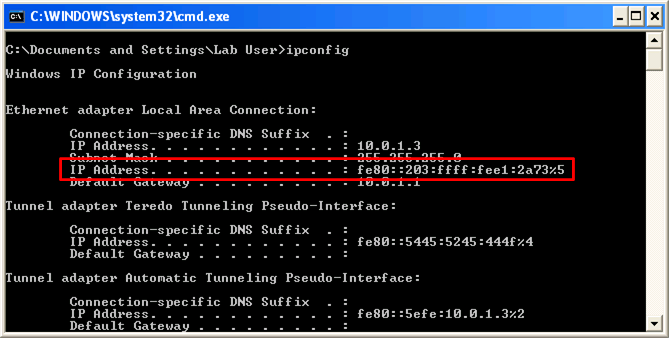In a computer network, a link-local address is a network address that is valid only for communications within the network segment (link) or the broadcast domain that the host is connected to.
Link-local addresses are usually not guaranteed to be unique beyond a single network segment. Routers therefore do not forward packets with link-local addresses.
For protocols that have only link-local addresses, such as Ethernet, hardware addresses that the manufacturer delivers in network circuits are unique, consisting of a vendor identification and a serial identifier.
Link-local addresses for IPv4 are defined in the address block 169.254.0.0/16, in CIDR notation. In IPv6, they are assigned with the fe80::/10 prefix.
Address assignment
Link-local addresses may be assigned manually by an administrator or by automatic operating system procedures. For Internet Protocol (IP) networks, they are assigned most often using stateless address autoconfiguration. In IPv4, they are normally only used to assign IP addresses to network interfaces when no external, stateful mechanism of address configuration exists, such as the Dynamic Host Configuration Protocol (DHCP), or when another primary configuration method has failed. In IPv6, link-local addresses are mandatory and required for the internal functioning of various protocol components.
Automatic address configuration of link-local addresses is often non-deterministic as the resulting address cannot be predicted. However, in IPv6 it is usually derived automatically from the interface media access control (MAC) address in a rule-based method.
IPv4
In RFC 3927, the Internet Engineering Task Force has reserved the address block 169.254.1.0 through 169.254.254.255 for link-local addressing in Internet Protocol Version 4. Link-local addresses are assigned to interfaces by host-internal, i.e. stateless, address autoconfiguration when other means of address assignment are not available.
RFC 3927 warns against the simultaneous use of IPv4 addresses of different scope, such as configuring link-local addresses as well as globally routable addresses on the same interface. Therefore, hosts search for a DHCP server on the network before assigning link-local addresses.
In the automatic address configuration process, network hosts select a random candidate address within the reserved range and use Address Resolution Protocol (ARP) probes to ascertain that the address is not in use on the network. If a reply is received to the ARP, it indicates the candidate IP address is already in use; a new random candidate IP address is then created and the process repeated. The process ends when there is no reply to the ARP, indicating the candidate IP address is available.
When a globally routable or a private address becomes available after a link-local address has been assigned, the use of the new address should generally be preferred to the link-local address for new connections but communication via the link-local address is still possible.
Microsoft refers to this address autoconfiguration method as Automatic Private IP Addressing (APIPA). It is sometimes also casually referred to as auto-IP.
IPv6
In the Internet Protocol Version 6 (IPv6), the address block fe80::/10 has been reserved for link-local unicast addressing. The actual link local addresses are assigned with the prefix fe80::/64. They may be assigned by automatic (stateless) or stateful (e.g. manual) mechanisms.
Unlike IPv4, IPv6 requires a link-local address to be assigned to every network interface on which the IPv6 protocol is enabled, even when one or more routable addresses are also assigned. Consequently, IPv6 hosts usually have more than one IPv6 address assigned to each of their IPv6-enabled network interfaces. The link-local address is required for IPv6 sublayer operations of the Neighbor Discovery Protocol, as well as for some other IPv6-based protocols, like DHCPv6.
In IPv6, stateless address autoconfiguration is performed as a component of the Neighbor Discovery Protocol (NDP), as specified in RFC 4862. The address is formed from its routing prefix and the MAC address of the interface.
IPv6 introduced additional means of assigning addresses to host interfaces. Through NDP routing prefix advertisements, a router or a dedicated server host may announce configuration information to all link-attached interfaces which causes additional IP address assignment on the receiving interfaces for local or global routing purposes. This process is sometimes also considered stateless, as the prefix server does not receive or log any individual assignments to hosts. Uniqueness is guaranteed automatically by the address selection methodology (MAC-address based according to RFC 4862, and/or randomized according to RFC 4941) in combination with the duplicate address detection algorithm.
Media access control
Media access control (MAC) addresses used in local broadcast networks, such as Ethernet, are link-local addresses. Such devices are configured with an address in hardware by the manufacturer. However, operating system utilities, such as ifconfig may be used to assign or change these addresses. This is essential when an operating system is running in a virtual machine environment.

